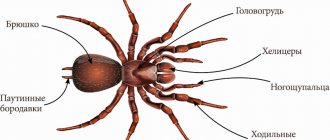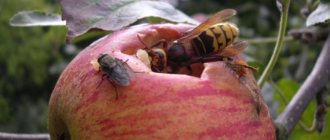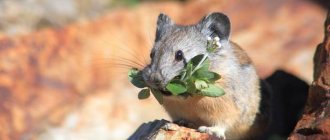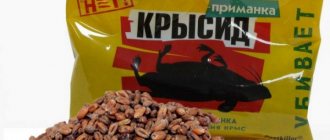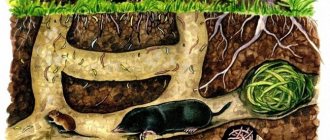- November 26, 2018
- Hunting
- Ekaterina Gordeeva
The farmer went out into the garden in the morning and grabbed his head. All the crops are turned inside out, there are strange holes around them. And the roots are gnawed.
Who did it? The first thought is that the moles tried. These diggers had nothing to do with it, because the river rats came to visit. If there is a body of water nearby, it’s definitely their business.
We'll talk about these animals in more detail in the article.
Who are you?
What kind of animal is a water rat? A pest that farmers and gardeners really dislike. Not only does the cute creature cause damage by damaging seedlings, but it also robs the beds.
River rats are the closest relatives of wild pasyuki. They have extreme gluttony and reproduce quickly. What does the animal look like? More on this below.
Animal nutrition
It’s not hard to guess what the water rat eats. The animal, despite its cute appearance, is a predator. In terms of feeding, it is practically no different from an ordinary domestic rat. It can eat grain crops, cereals, vegetables in large quantities, gnaw trees, and is not averse to eating other small mice.
Scientists have noticed that the vole population increases once every 8 years. Individuals begin to populate all areas suitable for life, causing damage to agriculture and gardens. During the warm season, an adult reproduces 2 offspring. By autumn, the baby rats have time to grow up and cause harm on a par with adults.
Description
The word “rat” makes some people cringe. If you look closely, both common and river rats are not so nasty. The latter are not particularly large comrades. They weigh about 250 grams. Their sizes vary from 20 to 25 centimeters.
They look like a pig and a guinea pig at the same time. A sort of strange hybrid: the snout of an underwater rat is short and rectangular, like that of a guinea pig, and the body of a rat is long, flexible, with a thin tail. By the way, the tail is covered with hairs and does not cause such disgust as a bald rat.
The water rat has long and thick fur. The upper part of the body (head, neck and back) is brown-gray. This is where the name came from - water rat. It seems that the color is ugly, but it is not. The photo shows that the animal is quite cute and its color scheme is in order.
The chest and belly of the animals are lighter than the main color.
Theoretical information
Whiskers help the rat maintain orientation in any space.
The vibration frequency of the whiskers is 8 Hertz. Certain species of rats can be very large: for example, Gambian rats grow up to 4 kg. The French entrusted the rat with space exploration in 1961. The female rat carries her babies for about 21 days, and immediately after giving birth she is ready to conceive again. In just three months, a rat can become the mother of hundreds of babies. Water rat
But despite such a high birth rate of these animals, there are only two rats for every person. The skeleton of an individual rat, increased to the average height of a human, has the same structure of joints and the same number of bone elements. Heart pulsation reaches half a thousand beats per minute. Rat tail hairs are one of the necessary elements for eye surgeries. It will take the rat half a second to sense the direction of the smell. Being at very distant distances, rats will accurately determine the location of food. Using their sense of smell, rats recognize members of their family and can even stake out areas. And among the rats there are watchers!
Rats' teeth grow throughout their entire, albeit short, lives. That is why they always need to chew something to grind off the excess part. Rats can easily chew through both metal and concrete products. Rats are not able to sweat, and their temperature is measured by their own tail. They communicate in their own language, which only they understand, using a throat whistle.
The water (field) rat is part of the hamster family. The animal owes its name to its habitat, since there will definitely be a body of water next to it - a river, lake or pond. Although during the flood period the vole prefers to move to meadows or vegetable gardens. In length, including the tail, the rat grows up to 25 cm. The body is massive, has a brown color, the fur is dense and thick, the muzzle is blunt. It digs long burrows for its home, which has a negative impact on the vegetable garden. Residents of private houses or owners of summer cottages often encounter this pest, but they cannot cope with it. During the summer, the female gives birth to offspring 2-3 times, and the number of cubs can reach up to 10. As a result, two dozen rats can breed up to 150-300 individuals over the summer, which will lead to the depletion of any crops.
Where did you come to us from?
What is the name of the water rat and where does it live? We will answer the first part of the question a little later. We will talk about the place of residence of the beast in this subsection.
You can find a surprise in the form of a pest everywhere. The rodent is distributed throughout Russia.
In the warm season, the animal lives calmly in various bodies of water. A pond, a river, a lake—it’s all his family. It can even live in swamps.
With the onset of cold weather, river rats begin to think about a hole. In order to create it, they move to the meadows, where they dig a nest for wintering. “Old pensioners” don’t like to move. They build houses for themselves right in the swamp hummocks or next to their native pond. Is there a dead tree nearby? Rodents are happy and happy. They will make a mink, bring herbs there and spend the winter there.
Where does it live?
The vole's habitat is very wide - it is almost the entire northern part of Eurasia from the very coast of the Atlantic to Yakutia and the Mediterranean Sea, including Asia and Mongolia with the territory of China. The vole occupies most of the non-chernozem territory of Russia, the Baltic states, Belarus, Ukraine, the Caucasus, the Volga region and Kazakhstan.
Moreover, of all mouse-like rodents, the vole is characterized by the highest rate of migration activity. And this species is distinguished by several types of migration, depending on the nature of the reasons that cause them:
- feeding migration (usually during seasonal evictions);
- migrations of dispersal and concentration;
- migration of competition (in case of displacement);
- migration displacement by natural disasters.
Moreover, for example, migration options can be either seasonal or short-term – up to a day – when the animal goes out in search of food and returns to its burrows. And the distance of such daily migrations can be up to 2 km, and in the case of seasonal movement - even up to five.
Water voles usually set up their huts on the banks of reservoirs that are covered with vegetation and are not characterized by fast currents and a constant flow level. This animal is often found in hilly areas and even in mountainous areas. They form their nests from grass and a wide variety of plant materials - and arrange them in plant trunks, on floating islands, inside (or on top) of hummocks.
In winter, the vole digs holes for itself away from the water - and in the regions of central Europe, the vole completely switches to a lifestyle similar to the existence of a mole.
Water voles are able to settle in both the vegetable garden and the garden - they gnaw the roots of trees, and, naturally, summer residents wage an irreconcilable struggle with representatives of this species.
Do you want to eat?
What is the official name of the river rat? A little patience, we'll tell you soon.
Let's talk about rodent nutrition for now. What does the animal that lives in and near water bodies eat?
Sedge, reeds, and reed shoots are the main diet of the water rat. They do not disdain marsh plants either. Of course, if they themselves live there.
Why do rats go to a person’s garden if they are provided with food? Rodents' favorite foods grow there. Aquatic comrades love root vegetables: potatoes, for example. Moreover, give them straight tubers, without rot or flaws. For the winter, reserves are made only from these.
They will happily eat beets and carrots. This is a favorite treat of river rats.
During the winter, supplies run out. So the animals have to go into human gardens. It would seem, what can you find there in the spring? People ate everything themselves. But don’t forget about the roots of garden plants. Water rats do not disdain them and eat them with great appetite.
Interesting facts about the rodent:
- The water vole is a widespread pest of agricultural crops and pastures. Rodents cause significant damage to all field crops that grow in floodplains and near water bodies. The water vole also causes damage in pastures and hayfields, in gardens and nurseries, in vegetable gardens and vegetable warehouses. This species not only feeds on grain crops, but also makes harvesting difficult. In addition, the water vole damages seedlings of garden and forest trees, thereby causing damage to horticulture and forestry.
- This species is a carrier of the pathogens of tularemia, Omsk hemorrhagic fever, leptospirosis and other diseases that are transmitted by blood.
- Water vole skins are used as fur and are harvested in large quantities.
Reproduction
Once a female water rat reaches eight weeks of age, it can give birth to pups.
Reproduction begins in the spring. And lasts until autumn. From approximately April to October, new representatives of river rats are born.
Animals are very fertile. Of course, twenty pieces won’t be born at once. But 7-10 rats per litter is easy. And during the warm period, one female can bring up to five litters, that is, thirty-five to fifty cubs. And that's just from one mother.
Rats live with their mother for about a month. At the age of 4-5 weeks they slowly become independent. They find food for themselves and learn to build nests. By the age of two months they leave the parental burrow.
Continuation of the family line
Breeding females fiercely defend their individual territories ranging in size from 30 to 150 m. The territories of males are somewhat larger - from 60 to 300 m, and overlap the ranges of several females.
The breeding season of water rats lasts from March until late autumn. During this time, one female gives birth to up to four litters. The gestation period is short, 21 days, and subsequent matings usually occur soon after the birth of the newborns.
Females usually give birth to 2 to 8 cubs, each weighing 5-10 grams. Cubs are born completely helpless, but they quickly develop and become independent. Already at 5 days old they open their eyes, and 14-21 days after birth the mother stops feeding them milk.
Sexual maturity occurs during their first summer of life, if they are born early in the season, or in the next mating season. Females can mature as early as 5 weeks of age.
sea rat
There is no such thing in nature. Doesn't exist, period. There is a water rat or guinea pig. The latter is called a rat, which causes confusion with the names.
Guinea pigs do not live in bodies of water. This is a land-based pet, very affectionate and funny. The animal can sing songs, standing on its hind legs and whistling. He becomes attached to his owner and is happy to make contact with him.
To live, such a “sea rat” needs a spacious cage, a place without drafts and direct sunlight, and special food. With good care they live up to 8 years.
Capabilities
The gray rat lives up to 3 years, but this is only if it is not sick, there is plenty of food, and there are no enemies. Usually such an idyll occurs only in laboratories or in home care. In nature, rats rarely live longer than one and a half years. Their abilities are unique. The fact that they anticipate earthquakes is not particularly surprising, because many animals can do this. But the fact that rats can predict where a shell will land is truly amazing. During the war, people, knowing about this talent of rodents, fled to those huts where the rats were hiding. A unique incident occurred in a market in France. It was moved to a new place, and already a day or two before, all the market rats had moved there, although, of course, no one informed them about this. Scientists have found that gray rats make about 5 thousand sounds, that is, they have their own “alphabet”.
These animals remember our faces and feel our character. They are able to pick up the slightest noise even in the 40 kHz range, which is used in electronic repellers. They distinguish two colors - blue and greenish. They dream, love classical music, and know how to laugh.
Relation to water voles
People are divided into two camps: some are crazy about these rodents. The latter consider them terrible and vile pests.
The first ones keep water rats at home. They equip entire aquariums with artificial burrows for such unusual pets.
Buying such an animal is not easy. There are almost no breeders in Russia, and rodent fans have to make a lot of efforts to acquire such a miracle.
Those who oppose river rats actively fight against them. As a rule, these are farmers whose gardens are damaged by animals.
Natural enemies
Rats try to avoid “communication” with representatives of canines and cats, as well as snakes and snakes. Their real enemies are: kites, eagles, owls. If foxes or beavers live in the region where rats live, a real war begins between them and the rodents.
In India, mongooses actively fight toothy pests. Some countries of the world (Japan, Colombia, New Zealand) periodically experienced an overabundance of breeding rats, threatening to destroy the entire harvest. In such cases, cats always came to the rescue, which were specially brought into the country to establish biological balance.
How to deal with water rats?
This question is asked by those who are “lucky enough” to encounter animal activity. It’s not pleasant to see a vegetable garden that’s all covered in bumps. Moreover, the roots of the plants were uprooted, scattered over the beds and carefully sprinkled with earth on top.
How to deal with river voles? There are several ways:
- Rat poison. It works effectively. Only the method is dangerous; the poisoned bait can be eaten by your own cat or dog. And if a small child picks up a piece of sausage, what happens? Therefore, it is better to come up with another way.
- Trap. It is useless in open areas. But in barns or a grain barn it is a very useful thing. River voles not only tend the garden, they also visit the barn with supplies.
- Glue trap. Suitable for both open and closed areas. The thief rodent will get into it and stick. All that remains is to get rid of it.
What does it eat?
In summer, the vole prefers to feed mainly on green food - coastal and floating succulent plants (water lilies, reeds, horsetail and much more). These animals love the root parts of plants, flowers, seeds and tree bark. The vole prefers to feed in certain places, where it even forms special “feeding tables” - areas for eating with the remains of a meal.
Occasionally, a vole is able to obtain animal food - beetles, mollusks and something else. In the fall, after the vegetation dies, the vole begins to feed on other parts of the plants - tubers and rhizomes. Their habits also include organizing supplies for the winter.
A vole, as a rule, adheres to the rule of living in its own territory - for example, the usual territory of a male is about 130 meters of coastal territory. In the female this area is slightly smaller. They are capable of organizing an extensive system of burrows on their territory, where there is even space for a nest and storage rooms. Often, the entrances to voles’ habitats are camouflaged under water – after all, these animals can swim well.
The vole is an active animal both during the day and at night, but prefers the morning hours for its walks.
As a rule, water voles do not live in large families and colonies - an exception may be animals that live far from waterways.
Typically, after particularly productive seasons, the vole population increases, which can cause significant damage to the entire agricultural sector. Over time, the population, of course, decreases - and such swings occur regularly, depending on the food supply. Such cycles repeat approximately once every three to four years.
Folk remedies
What do experienced farmers advise? How to get rid of the nasty water rat from your property?
- Start by concreteing the bottom of the fence that encloses the area. The water vole will not undermine the ground. He will leave immediately.
- Rodents do not like the smell of onions and peppermint. Plant them in different areas of your garden.
- Found a hole? Take a rag and soak it in kerosene or acetone. We put the rag in a regular bag and make a small hole in it. We put the package in the hole.
- The smell of burnt wool will help drive uninvited guests out of the area. Scatter a small amount over the area.
- Sprinkle the area with wood ash. If a water rat tastes it, it will cause an upset stomach. In addition, ash causes skin irritation in rodents. Constant poor health associated with visiting your site will force the animal to stop coming here.
- Rodents and burrs are afraid. They stick to the fur and then do not come off, causing a lot of inconvenience to the rat. Thistle will save you from visits from the beast. Tangles of burdock are scattered around the site.
What harm can it cause
The main harm of a water rat to humans:
- this type of rat damages the bark and roots of trees and shrubs in gardening;
- causes significant damage to cereal plants;
- the construction of holes contributes to the destruction of the slopes of dams and canals;
- damages stocks of vegetables and grains;
- is a carrier of a number of serious diseases for humans.
The only benefit of water rats for humans is the use of their skins in the hat production industry.
Agriculture
The damage to agriculture from the water rat is quite large:
- damage to the roots of shrubs and fruit trees (apple, currant, gooseberry), as the animal gnaws them as winter food;
- damage to cereal crops;
- damage to vegetables and fruits.
Diseases
A rat is a rodent that can be found in garbage, where it feeds on waste. Sometimes in apartments and houses a rat ends up in the sewer. Such a rat can pose a danger to health and even life, since it spreads many diseases, including those that can be fatal to humans.
Leptospirosis
Leptospirosis is a disease caused by Leptospira spirocheetes, spread by domestic and wild animals, especially rodents and livestock, as well as pigs, horses and dogs. The disease is characterized by the occurrence of fever, circulatory disorders with vascular damage or changes in parenchymal organs, nervous system and muscles.
Leptospirosis is an infectious disease that mainly affects miners, plumbers, canal workers, farmers, people who swim in contaminated water bodies and come into contact with feces of infected animals. Leptospirosis viruses tolerate low temperatures and even freeze well. In dirty standing water or damp soil they can easily survive for up to several weeks. The source of infection is the urine of sick animals. The infection most often occurs on damaged skin.
Symptoms of leptospirosis:
- heat;
- chills;
- headaches, muscle and joint pain;
- congestion of the conjunctiva and mucous membrane of the throat;
- herpes;
- rash.
After the first symptoms appear, a person’s body temperature decreases, and a short-term improvement in health is observed. The viruses then disappear from the bloodstream and begin to localize in various organs and tissues, causing toxic inflammatory changes. After some time, the temperature rises again, and the so-called icteric form of the disease with a focus of inflammation in the liver, kidneys, meninges, heart or lungs.
Fever
Q fever is transmitted by inhalation through inhalation of dust from the excrement of sick rats, or through spoiled food.
It is an infection with a febrile syndrome and damage to the lungs, for example, with the development of atypical pneumonia.
Tularemia
Tularemia is a disease whose main source of infection is animals, such as hares, wild rabbits and rodents. Hence other names for tularemia - plague of rodents, disease of hares or rabbit fever.
Tularemia is a zoonotic infectious disease. There are different forms of tularemia, resulting from different routes of infection and symptoms. Some of them can have a very rapid course and lead to death, especially if they are not diagnosed and, therefore, not treated promptly.
Other diseases
When rats encounter humans, they usually run away. However, if a person finds them in a place where they cannot escape, they may feel threatened and defend themselves by attacking. In such a situation, they can bite a person and transmit diseases such as:
- plague;
- typhoid fever;
- jigsaw;
- leptospirosis;
- tularemia;
- salmonella;
- rabies;
- Rat bite fever: the disease is caused by infection with a rather atypical microorganism.
In addition, lice and fleas parasitize rats, which can carry many diseases that threaten the health and lives of people.
Attention! It is worth noting that infection can occur not only from a rat bite. Rats' feces and urine can also be a source of infection.
How to get rid of an animal
To combat water rats in the garden, shallow trenches are made around trees, into which a mixture of peat or ash with strong-smelling substances is poured. The trunk is tied with burlap or spruce branches.
You can dig deep fishing holes and place bait with poison or bleach on the bottom. They must be placed exactly this way, in holes, so that pets are not harmed.
It is worth using mole traps; they are placed at the entrance to a dug hole. In the same way, spring or arc traps and catch buckets are used.
If the area is large and is in a risk zone, it makes sense to install ultrasonic repellers, which also work on birds and moles.
Cats that catch rats will help get rid of these pests. Usually, water rats do not wander into an area where there are active cats and dogs.
folk remedies are also used
- rags soaked in machine oil are stuffed into the holes;
- pour stove soot diluted to the consistency of sour cream into the holes;
- pieces of singed rabbit skin are stuffed into holes;
- They use plants with thorns that cling tightly to the skin, and they are poured into holes.
How to get rid of rats in a barn
Rats in the barn scare the animals and steal eggs. You need to get rid of them quickly, but at the same time take care of the safety of other residents.
How to get rid of rats on your property
Rats on the site spoil crops, bulbs, roots and gnaw the bark or shoots of young trees. They must be removed quickly, without delay.
Population and species status
According to scientists, there are more than 60 species and subspecies of such rodents in the world. At the same time, it is quite difficult to distinguish species from species if you do not use the method of gene analysis.
Until now, the genome of this rodent has not been solved, since the genetic material is located chaotically, and the bulk of the information is located in the sex chromosomes. The number of chromosomes can be at the level of 17-64, and in females and males their number may not be the same. Despite this fact, all mice of the same litter are genetic clones.
The mouse population has one unique property, which is associated with the “self-transplantation” of genes into the nucleus from cells (mitochondria) of other organs. Scientists have been struggling with this problem for many years to no avail, which is associated with gene transplantation in humans, while a similar process in mice has been working for thousands of years. Scientists explain this by saying that mice made a sharp evolutionary leap in the next few million years.
The size of the vole mouse population depends on the year and season, with the cycle of birth surges being on the order of 3 to 5 years. Under favorable natural conditions, there can be up to 2 thousand individuals per 1 hectare of territory, and in unfavorable years - only a hundred individuals.
Lemmings and muskrats, like mice, also belong to the rodent family.
Wood vole close up / Bank vole close up
Watch this video on YouTube
Differences from other rodents
The ground rat differs from the gray rat in having soft fur and a shorter tail without ring scales.
They differ from moles in the smaller size of their underground passages, which also have an irregular shape. Also, rats do not hibernate in winter.
The tracks are similar to the prints of gray voles, but have a longer step length - 6-8 cm.
To compare the ground rat with other rodents, we suggest reading about pied voles, the mole vole, the red and banked voles, and the root vole.
Features of character and lifestyle
Photo: Water vole in Russia
The water mouse is a terrestrial nocturnal rodent. Constructed nesting mounds and natural or artificial depressions located near or above the high tide mark are used for shelter during the day and between tidal cycles. Man-made structures can also be used for shelter when no other suitable sites exist.
The water vole spends most of its day in creek bank burrows, but is mostly active around sunset when it comes out to feed, although it is also known to forage during the day. She builds a grass-lined nest at the entrance to her burrow, which is usually hidden among vegetation and built at the end of tunnels on the banks of rivers and lakes.
Interesting fact: Water vole burrows are usually hidden among vegetation and built along the banks of rivers and lakes. The round entrance has a diameter of about 15 cm.
Most water voles are skilled swimmers and aggressive underwater predators, but the African water vole (Colomys goslingi) wanders in shallow water or sits at the water's edge with its snout submerged. The water vole has adapted well to living with people. It was formerly hunted for its fur, but is now a protected species in Australia and the population appears to have recovered from the effects of hunting.
However, current potential threats to the species include:
- habitat modification resulting from flood mitigation, urbanization, and wetland drainage;
- predation by introduced animals such as cats, foxes and some native birds of prey;
- the young are also vulnerable to predation by snakes and large fish.



